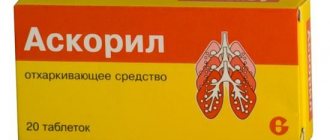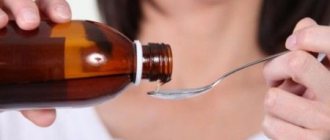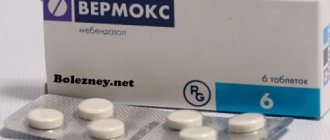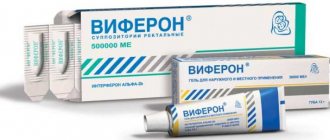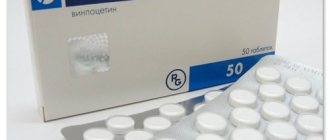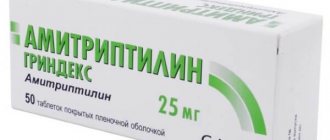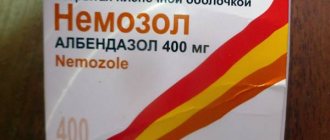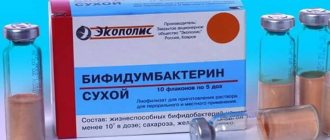Category: Published 11/01/2016 · Comments: · Reading time: 5 min · Views: 2,979
“Pantogam,” what do these nootropic tablets and syrup help with? The medicine has anticonvulsant properties. The instructions for use recommend taking the drug “Pantogam” for memory impairment, decreased mental activity, and Parkinson’s disease.
Pantogam active in capsules
Syrup, tablets "Pantogam": what does the drug help with?
There are the following indications for the use of the drug:
- deterioration of mental and physical activity;
- decreased concentration;
- memory impairment;
- psycho-emotional overload;
- extrapyramidal syndrome developing due to the use of antipsychotics;
- Parkinson's disease;
- chorea;
- epilepsy;
- extrapyramidal pathologies;
- cognitive impairments that develop as a result of the effects of neuroinfections and injuries on the brain, disorders of the nervous system;
- tics;
- enuresis;
- stuttering;
- encopresis;
- cerebrovascular insufficiency against the background of cerebral atherosclerosis;
- hyperkinetic disorders;
- schizophrenia;
- hyperactivity syndrome;
- pollakiuria.
Why is Pantogam prescribed to children?
The medicine is indicated for use in childhood with:
- violations of the child’s psychological status;
- speech disorders, movement functions;
- mental retardation;
- cerebral palsy;
- perinatal encephalopathy from birth.
Application area
For what purpose and why do specialists prescribe Pantogam to their patients:
- impairment of performance, psycho-emotional overload;
- therapy and prevention of extrapyramidal syndromes due to the use of antipsychotics;
- disturbances in active movement as a result of decreased muscle tone;
- cognitive problems due to TBI and neurotic disorders;
- neuroses with tics, stuttering, inorganic encopresis;
- changes in blood vessels as a result of the development of atherosclerosis;
- epilepsy with convulsive syndrome;
- schizophrenia with retardation;
- urinary disorders (urinary incontinence, enuresis);
- developmental delay in children, disorders of motor activity, speech, formation of school skills;
- mental retardation with behavioral disorders;
- different forms of cerebral palsy;
- damage to brain functions in children from the first day of life.
Article on the topic: How the sleeping pill Donormil works - instructions for use, reviews and analogues of the drug
Contraindications
The instructions for use prohibit taking Pantogam tablets when:
- pregnancy;
- breastfeeding;
- severe kidney disease;
- hypersensitivity to the composition of the syrup, Pantogam tablets, which causes allergies.
This form is not prescribed to children under 3 years of age. The syrup should not be taken:
- for kidney problems;
- phenylketonuria;
- pregnant women in the early stages;
- non-acceptance of the composition.
By
Composition and effect on the body
Pantogam active contains D, L-Hopantenic acid (racemic complex). Thanks to the L-isomer, the interaction of the main component with the GABA receptor (neurotransmitter of the central nervous system) is enhanced.
Pantogam active simultaneously has a psychotropic and nootropic effect on the body, therefore it is considered a “nootranquilizer”. Main properties of the medicine:
- The drug overcomes the blood-brain barrier, increasing the resistance of brain cells to the adverse effects of toxins and hypoxia, and activates anabolic processes (metabolism of amino acids, fats, polysaccharides) in neurons.
- Anti-anxiety, mild anticonvulsant, antiasthenic effect.
- Reduces motor excitability, improves physical endurance and mental activity.
- Has an inhibitory effect in bladder reflux.
- Prevents the development of adverse reactions with long-term use of Carbamazepine, Phenobarbital, and neuroleptics.
The instructions for use of Pantogam Active specify that the drug can be used simultaneously with other drugs. Therefore, this drug is prescribed to elderly patients; at this age, most patients regularly take many types of pharmaceuticals simultaneously for the treatment of chronic pathologies.
Reviews about Pantogam active are positive, and this is explained by certain features of the nootropic:
- The drug has a moderate sedative effect.
- The use of the medicine does not affect blood pressure levels.
- There is no hyperstimulation effect.
- The medication is used over a long course, it does not develop addiction, and there is no withdrawal effect.
It is better to use it after prior consultation with a doctor.
The therapeutic effect of Pantogam Active and the improvement in general well-being depend on how correctly the dosage and total duration of administration are determined.
Neurologists and psychiatrists know why Pantogam active is prescribed to adults and how the drug will act on the body. Taking the medication is part of the treatment of chronic diseases of the central nervous system, that is, it complements the effect of the main treatment.
Medicine "Pantogam": instructions for use
Both syrup and tablets are taken orally 30 minutes after meals. Since the drug creates a nootropic effect, it is advisable to drink it in the first half of the day. The daily volume for adults is 1.5-3 g, for children - 0.75-3 g, a single dosage, respectively - 0.20-1 g and 0.20 - 0.5 g (for children). The duration of therapy takes 1-4 months. It is possible to extend treatment up to 6 months. After a 3-month break, the doctor may prescribe a second course.
Instructions for use of the drug "Pantogam" for the treatment of diseases
For epilepsy, the drug is prescribed in a daily volume of 0.75-1 g, combining it with anticonvulsants. Duration of treatment is 12 months or more. To treat the consequences of exposure to neuroinfections and head injuries, the medicine is taken 3-4 times a day, 0.2 g.
For neuroleptic extrapyramidal syndrome, the medication must be taken daily for several months. The daily dose is 3 g. For extrapyramidal syndrome that has developed due to the use of antipsychotics, Pantogam is prescribed to children in an amount of 0.2-0.5 g 3-4 times a day, adults need to drink the medicine three times a day, 0.5 -1 g.
Treatment of extrapyramidal hyperkinesis is carried out by prescribing the drug "Pantogam" in a daily dose of 0.5-3 g. It should be taken for 4 months. For asthenia, mental and emotional overload, it is recommended to use the medicine three times a day, 0.2 g. For children with abnormalities of the central nervous system, the medicine is given in a daily volume of 1-3 g.
Children with tics are given 0.2-0.5 g of the drug 3 to 6 times a day. Treatment continues for up to 4 months. Adult patients are prescribed 1.5-3 g per day for 1-5 months. For impaired urination, children should take 0.2-0.5 g per day. The product is drunk for 1.5-3 months. Adults are advised to consume 0.5-1 g 2-3 times a day for 1-3 months.
Conditions of storage and release from pharmacies, expiration date
The syrup should be stored in a place protected from exposure to sunlight and ensure that it is inaccessible to children. Storage temperature: 15-25 °C.
The syrup is sold to customers with a doctor's prescription.
Pantogam is stored for 2 years. The drug should not be used after the expiration date indicated on the label.
Special instructions and drug interactions
You should not use other nootropics that stimulate the central nervous system together with Pantogam. At the initial stage of treatment, there is a risk of drowsiness, so it is advisable to refrain from driving and performing hazardous work. An interval of 1-3 months is required between courses of therapy.
The drug prolongs the effect of barbiturates, eliminates unwanted effects that occur after the use of neuroleptics, phenobarbital, carbamazepine. The medication enhances the properties of anticonvulsants and local anesthetics. Glycine and Etidronic acid help increase the effectiveness of Pantogam.
Interaction with other drugs
When taken simultaneously with barbiturates, it prolongs the effect of the latter. When used together with anticonvulsants and local anesthetics, their effect is enhanced. Pantogam prevents the side effects of phenobarbital, antipsychotics, and carbamazepine. Glycine and xydiphone can enhance the effect of Pantogam.
Pantogam is not recommended for long-term use with other nootropics.
Opinions of patients and doctors
Reviews from specialists who use them in neurology about the action of Pantogam tablets are positive. Most patients trust the medication and consider treatment with the drug satisfactory. Parents respond well to the effect of the syrup.
Many people ask: “Which is better, Pantogam or Pantocalcin?”
Doctors answer that there is no big difference in the use of the products. Both medications contain hopantenic acid. Their cost and effectiveness are comparable.
Composition, pharmacological forms
The manufacturer produces hopantenic acid in the form of a crystalline powder, which is highly soluble in water and poorly soluble in ethyl alcohol. The crystals are white, but when dissolved the water remains clear. The substance has no specific odor. It can also be included in a suspension or tablets intended for oral use.
In accordance with the manufacturer's annotation, its chemical composition is as follows:
- Calcium hopantenate – 250 mg.
- Microcrystalline cellulose.
- Main magnesium carbonate.
- Calcium stearate.
- Potato starch.
- Talc.
Hopantenic acid can be produced by the manufacturer in the form of powder, liquid suspension, capsules, tablets. The active substance has increased activity aimed at stimulating the activity of the brain and central nervous system organs. To avoid harmful effects, the drug should be used on the advice of a competent specialist and in accordance with individually prescribed dosages.
Reviews
Here are some reviews from parents whose children took Pantogam, which will to some extent help us analyze why this drug is prescribed to children, how effective it is, and what are the practical disadvantages of using this drug.
Tatyana writes that her child was prescribed Pantogam from the age of two months, but she was afraid to give her child the drug after reading the instructions. However, at the age of three, the girl’s seizures intensified and Pantogam was prescribed again, but in a higher dosage. She still recommends following doctors' recommendations.
Omelia tells the story of her daughter using Pantogam from 3 weeks of age for 2.5 months in combination with massage for weak motor reflexes. The treatment turned out to be completely effective.
Ekaterina describes her experience of using Pantogam: it was prescribed to her child due to increased muscle tone and dilated ventricles of the brain (according to the examination) as a drug that improves metabolic processes and blood circulation in the brain. The ventricles became smaller as a result of treatment.
Irina Ivanovna notes that when using Pantogam, her child became more excitable and sleep was disturbed, so after consultations with many neurologists, she had to stop the drug, given this effect. He advises looking at the child’s reaction to the drug and not using it in such cases.
Elena writes that her child was prescribed to take Pantogam for a chorionic plexus cyst and ischemic syndrome. The drug was taken, but no particular effectiveness was noticed, at least in terms of external behavior. The cyst had resolved by six months.
Opinions vary and are personal and situational in nature. Indeed, the drug is effective when it is used strictly according to indications and a certain course of treatment. It must be prescribed by the attending physician, and its use must be supervised by him.
Cases of overdose and side effects
If you mistakenly take a larger amount of the drug, an increase in adverse reactions occurs: drowsiness, insomnia, noise in the head and headache.
You should perform a gastric lavage, drink activated charcoal or Smecta. Treat symptoms as needed. An overdose occurs when an increased dose of medication is taken by mistake; this indicator is individual for each person.
Side effects from taking Pantogam include allergic manifestations:
- rhinitis;
- conjunctivitis;
- skin rashes.
To eliminate them, a dose reduction or complete discontinuation of the drug is required. Insomnia or drowsiness, noise and pain in the head often occur. There is no need to cancel treatment - this is a short-term phenomenon.
Article on the topic: Myotropic antispasmodic drugs: mechanism of action
Side effects
Treatment may be accompanied by:
- allergic rhinitis;
- conjunctivitis;
- skin rashes;
- disturbances in sleep-wake patterns;
- tinnitus.
These symptoms do not require discontinuation of the drug or symptomatic treatment. They go away on their own in a short time.
The most common side effect when taking the drug is the development of an allergy to the components of the composition.
As a rule, therapy using Pantogam occurs without serious complications.
Sometimes side effects in the form of allergic reactions (rashes on the skin, conjunctivitis, rhinitis) are possible. In this case, reduce the dose of Pantogam or cancel therapy with its use.
Also, noise in the head, sleep phase disturbances or daytime sleepiness were observed. These symptoms usually do not require discontinuation of treatment and are short-lived.
- Allergic reactions: conjunctivitis, rhinitis, skin rashes (these reactions require a reduction in the dose of Pantogam or its complete withdrawal);
- Other: drowsiness or sleep disturbances, noise in the head (these phenomena are usually short-term and do not require cessation of therapy).
